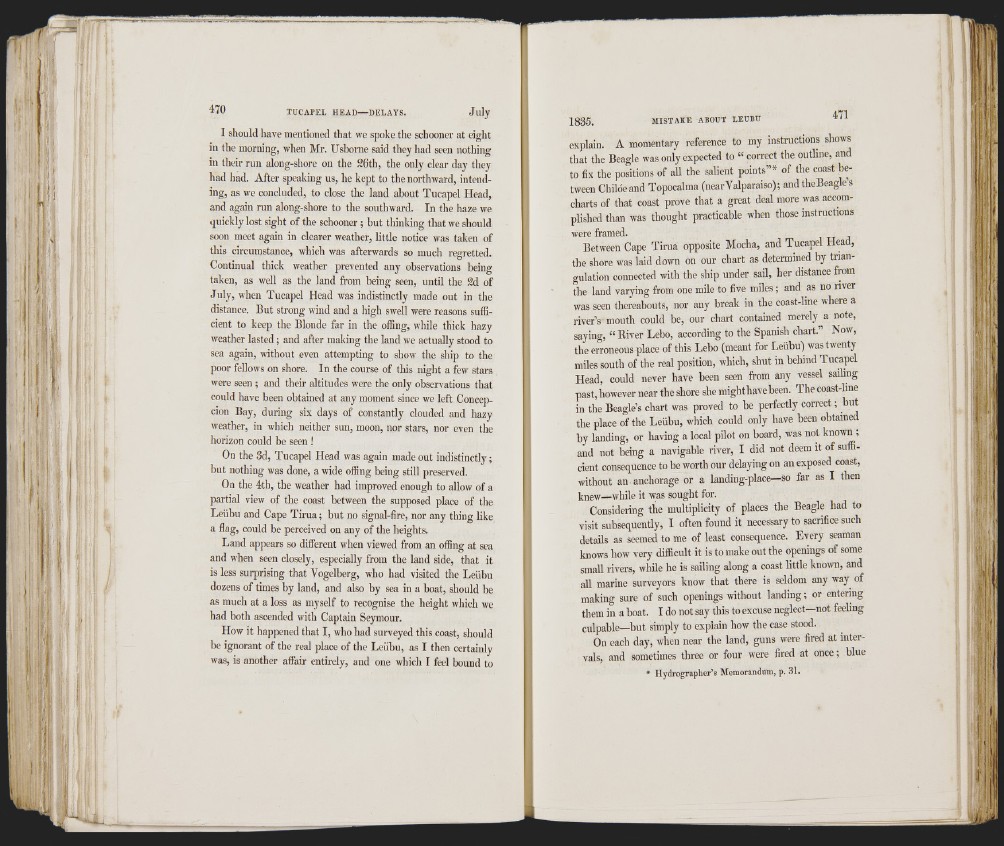
S 'il
I: 00
470 TÜCAPEL HEAD DELAYS. J uly
I should have mentioned that we spoke the schooner at eight
in the morning, when Mr. Usborne said they had seen nothing
in their run along-shore on the 26th, the only clear day they
had had. After speaking us, he kept to the northward, intending,
as we concluded, to close the land about Tucapel Head,
and again run along-shore to the southwai'd. In the haze we
quickly lost sight of the schooner ; but thinking that we should
soon meet again in clearer weather, little notice was taken of
this circumstance, which was afterwards so much regretted.
Continual thick weather prevented any observations being
taken, as well as the land from being seen, until the 2d of
July, when Tucapel Head was indistinctly made out in the
distance. But strong wind and a high swell were reasons sufficient
to keep the Blonde far in the offing, while thick hazy
weather lasted ; and after making the land we actually stood to
sea again, without even attempting to show the ship to the
poor fellows on shore. In the course of this night a few stars
were seen ; and their altitudes were the only observations that
could have been obtained at any moment since we left Concepcion
Bay, during six days of constantly clouded and hazy
weather, in which neither sun, moon, nor stars, nor even the
hoi'izon could be seen !
On the 3d, Tucapel Head was again made out indistinctly ;
hut nothing was done, a wide offing being still preserved.
On the 4th, the weather had improved enough to allow of a
partial view of the coast between the supposed place of the
Leiibu and Cape Tirua; but no signal-fire, nor any thing like
a flag, could be perceived on any of the heights.
Land appears so different when viewed from an offing at sea
and when seen closely, especially from the land side, that it
is less surprising that Vogelberg, who had visited the Leübu
dozens of times by land, and also by sea in a boat, should be
as much at a loss as myself to recognise the height which we
had both ascended with Captain Seymour.
How it happened that I, who Iiad surveyed this coast, should
be ignorant of the real place of the Leiibu, as I then certainly
was, is another affair entirely, and one which I feel bound to
1835. MISTAKE ABOUT LEUBU 471
explain. A momentary reference to my instructions shows
that the Beagle was only expected to “ correct the outline, and
to fix the positions of all the salient points”* of the coast between
Chiloe and Topocalma (near Valparaiso); andtheBeagle’s
charts of that coast prove that a great deal more was accomplished
than was thought practicable when those instructions
were framed. i tt j
Between Cape Tirua opposite Mocha, and Tucapel Head,
the shore was laid down on our chart as determined by triangulation
connected with the ship under sail, her distance from
the land varying from one mile to five miles ; and as no river
was seen thereabouts, nor any break in tbe coast-line where a
river’s mouth could be, our chart contained merely^^a note,
saying, “ Iliver Lebo, according to the Spanish chart.” Now,
the erroneous place of this Lebo (meant for Leübu) was twenty
miles south of the real position, which, shut in behind Tucapel
Head, could never have heen seen from any vessel sailing
past, however near the shore she mighthavebeen. The coast-hne
in the Beagle’s chart was proved to be perfectly correct ; hut
the place of the Leübu, which could only have been obtained
by landing, or having a local pilot on board, was not known ;
and not heing a navigable river, I did not deem it of sufficient
consequence to be worth our delaying on an exposed coast,
without an anchorage or a landing-place—so far as I then
knew—while it was sought for.
Considering the multiplicity of places the Beagle had to
visit subsequently, I often found it necessary to sacrifice such
details as seemed to me of least consequence. Lvery seaman
knows how very difficult it is to make out the openings of some
small rivers, while he is sailing along a coast little known, and
all marine surveyors know that there is seldom any way of
making sure of such openings without landing ; or entering
them in a boat. I do not say this to excuse neglect—not feeling
culpable—but simply to explain how the case stood.
On each day, when near the land, guns were fired at intervals,
and sometimes three or four were fired at once ; blue
* Hydrographer’s Memorandum, p. 31.
' »
•ÍI
Ij"
It
I (
!